Andrea and Antonella Ferrari photograph pair of mating mimic octopus
Mating Mimics
By Andrea and Antonella Ferrari
The Mimic was slowly flowing on the black sand bottom, leisurely spreading its long webbed white and purple banded arms without assuming that unmistakable flounder-like shape it typically takes when in flight mode, as it passed by a small unobtrusive hole in the substrate.
In a flash, another confusing shape unexpectedly emerged and jumped it, which we immediately recognized as another octopus, however quite smaller and sporting an altogether different livery, decidedly more subdued and lacking any specific markings. And yet it looked strangely familiar – a White-V or a Long-armed octopus perhaps, one of those muck-dwelling confusing species which presumably all belong to the horridus complex? Expecting a violent territorial dispute – octopi are well known for cruelly and clinically strangling each other to death on such arguments – we floated hesitantly above.
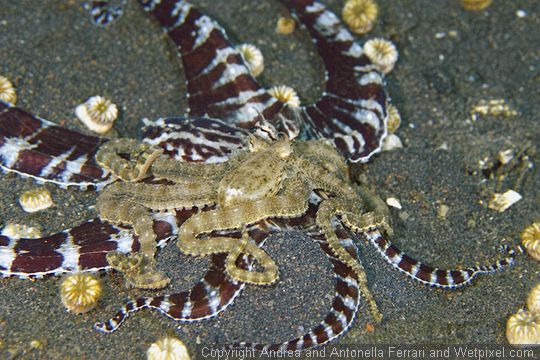
The smaller golden-tan individual, flashing pearl-like white spots along its frantically curling arms, had immediately straddled the Mimic and now started entwining its tentacles around the larger individual’s head sac, distinctly fondling it with its two curiously smaller and thinner front ones. Uh-oh - this seriously started looking like courtship, not fighting! Sliding and curling on the flat seabottom, the Mimic – still in its typical banded livery – now abruptly stopped and suddenly presented us with a dizzying doubled image of itself when its puzzling “rider” unexpectedly shifted hues, briefly flashing the unmistakable banded livery of mimics itself. Courtship all right, getting serious now!
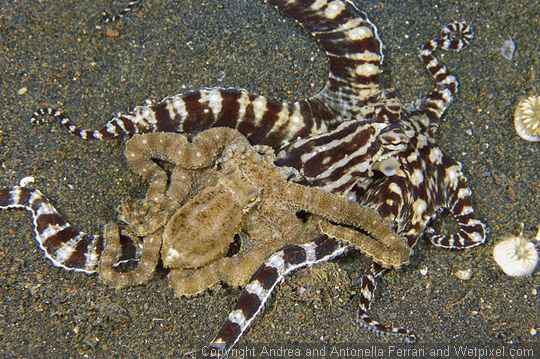
Ignoring the frantic flashes of our strobes, the two mimics now delicately snuggled in the soft sand, the smaller male clearly playing with the larger female, spread-eagling the larger and thicker writhing arms of its remissive companion while delicately inserting its specialized sperm-packing tentacle inside the head sac of the female. We usually are against anthromorphizing animal behavior, but on this occasion we could swear a long shiver of sensual pleasure coursed through the female’s body and arms, as the skin texture of both mimics turned to an exaggerated jumble of flaps and appendages such as we’d never witnessed before – in fact mimics’ bodies are usually quite smooth and unfrilled.
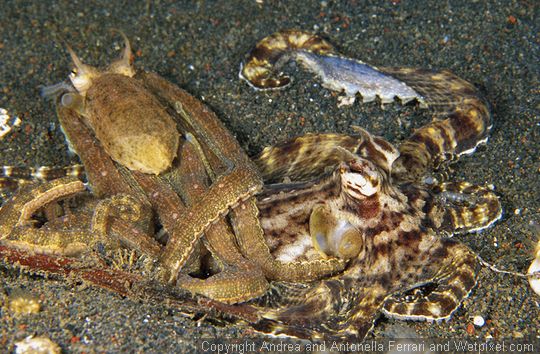
Still caressing the submissive female and happily oblivious of our presence, the male repeated its delicate penetration several times during the next forty minutes, all the while the two octopi presenting us with a veritable – and yet strangely beautiful – gorgon’s head of writhing tentacles and spookily stalked eyes.
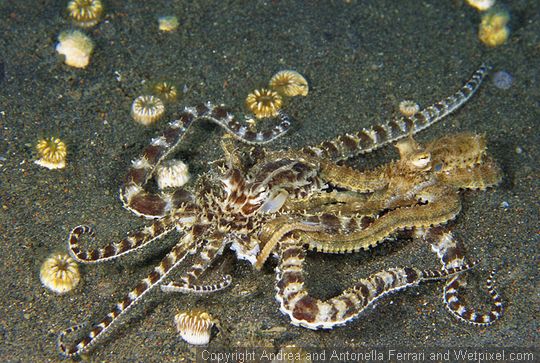
Then, as suddenly as it had started, intercourse was over. The male extricated itself from its lover’s embrace and dismissingly departed on its own – quite hurriedly, in fact – leaving the big female lying there, contendently snuggled up and in all honesty looking like she could do with a nice cigarette now.
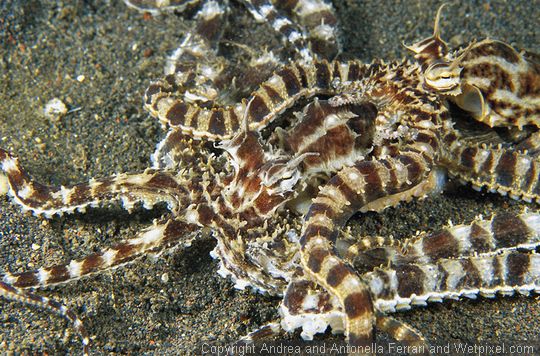
A very lucky occurrence – we simply happened to find ourselves at the right time in the right spot – which has however allowed us to document as best as we could a previously (to our knowledge) behavior of this rarely encountered, beautiful and very secretive species, and which now raises a few doubts: do male Mimic octopi Thaumoctopus mimicus always look so completely different from females when in repose, or the strange livery we have seen and photographed has something to do with courtship and mating? If so, it’s surprisingly a rather drab one, as males of most animal species usually get very flashy when looking for females.
And are those two specialized very small and thin front tentacles used for courting and mating purposes only? Females feature them too, but in fact they are quite larger and stronger on them (this is actually difficult to observe as most Mimics we have seen generally miss quite a few tips or even full tentacles due to predation or intraspecific fights). Was the speedy post-intercourse departure of the male a possible indication of expected cannibalistic behavior from the female, a not-uncommon occurrence in many species? We’re hoping in future contributions from other lucky divers and researchers – until then, happy and safe diving!
For a more complete set of mating Mimics pictures, please check Andrea and Antonella’s website, Reefwonders.